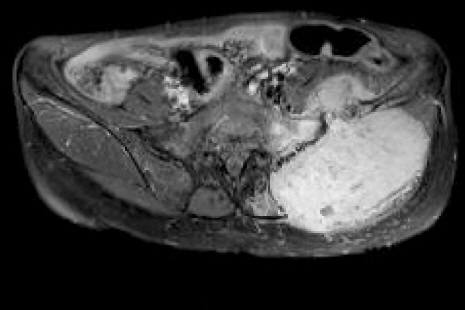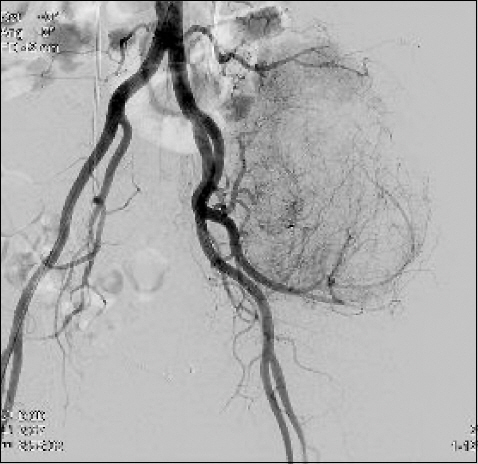Anesth Pain Med.
2017 Jul;12(3):281-285. 10.17085/apm.2017.12.3.281.
Perioperative anesthetic management of a patient with catecholamine-secreting paraganglioma: A case report
- Affiliations
-
- 1Department of Anesthesiology and Pain Medicine, National Police Hospital, Seoul, Korea. slpak@police.go.kr
- KMID: 2388848
- DOI: http://doi.org/10.17085/apm.2017.12.3.281
Abstract
- Paraganglioma is an uncommon neuroendocrine tumor of cells that originate in the autonomic nervous system. Some paragangliomas have the ability to secrete catecholamines, similar to secretions in pheochromocytoma. For this reason, paragangliomas may cause malignant hypertension in patient, upon being administered anesthesia, or during surgery, this may lead to a life-threatening condition, despite the tumor having been diagnosed before conducting the procedure. Therefore, it is important to take adequate actions for reducing the occurrence of morbidity and mortality during surgery. Here, we describe a successful anesthetic management in a patient diagnosed with retroperitoneal paraganglioma invading the iliac bone.
MeSH Terms
Figure
Reference
-
1. Ahmad S, Cathy D, Sheikh M, Sweeney P. Retroperitoneal extra-adrenal paraganglioma: a rare but important diagnosis. Ir J Med Sci. 2009; 178:211–4. DOI: 10.1007/s11845-007-0113-z. PMID: 18183473.2. Somasundar P, Krouse R, Hostetter R, Vaughan R, Covey T. Paragangliomas--a decade of clinical experience. J Surg Oncol. 2000; 74:286–90. DOI: 10.1002/1096-9098(200008)74:4<286::AID-JSO9>3.0.CO;2-C.3. Young WF Jr. Paragangliomas: clinical overview. Ann N Y Acad Sci. 2006; 1073:21–9. DOI: 10.1196/annals.1353.002. PMID: 17102068.4. Renard J, Clerici T, Licker M, Triponez F. Pheochromocytoma and abdominal paraganglioma. J Visc Surg. 2011; 148:e409–16. DOI: 10.1016/j.jviscsurg.2011.07.003. PMID: 21862435.5. Koumaras Ch, Anagnostis P, Tzimou M, Giavanidis I, Gossios T, Antoniadis A, et al. Paraganglioma in a young patient with asymptomatic severe hypertension: a case report and review of the literature. Hippokratia. 2010; 14:300–2. PMID: 21311646. PMCID: PMC3031332.6. Waguespack SG, Rich T, Grubbs E, Ying AK, Perrier ND, Ayala-Ramirez M, et al. A current review of the etiology, diagnosis, and treatment of pediatric pheochromocytoma and paraganglioma. J Clin Endocrinol Metab. 2010; 95:2023–37. DOI: 10.1210/jc.2009-2830. PMID: 20215394.7. Lee JA, Duh QY. Sporadic paraganglioma. World J Surg. 2008; 32:683–7. DOI: 10.1007/s00268-007-9360-4. PMID: 18224469.8. Kinney MA, Narr BJ, Warner MA. Perioperative management of pheochromocytoma. J Cardiothorac Vasc Anesth. 2002; 16:359–69. DOI: 10.1053/jcan.2002.124150. PMID: 12073213.9. Di Daniele N, Canale MP, Tesauro M, Rovella V, Gandini R, Schillaci O, et al. Preoperative embolization reduces the risk of cathecolamines release at the time of surgical excision of large pelvic extra-adrenal sympathetic paraganglioma. Case Rep Endocrinol. 2012; 2012:481328. DOI: 10.1155/2012/481328.10. Arai T, Hatano Y, Ishida H, Mori K. Use of nicardipine in the anesthetic management of pheochromocytoma. Anesth Analg. 1986; 65:706–8. DOI: 10.1213/00000539-198606000-00027. PMID: 3706810.11. Jeon HH, Chung RK, Lee H, Kim JH, Baik HJ, Han JI. Hypertensive crisis during percutaneous radiofrequency ablation of a metastatic adrenal tumor under general anesthesia: A case report. Anesth Pain Med. 2014; 9:70–2.12. Park SY. Perioperative management of cardiovascular medication. Anesth Pain Med. 2014; 9:153–8.
- Full Text Links
- Actions
-
Cited
- CITED
-
- Close
- Share
- Similar articles
-
- Anesthetic management of a patient with undiagnosed paraganglioma: a case report
- Endoscopic Resection of Functional Paraganglioma of the Pterygopalatine Fossa: A Case Report
- Hypertensive crisis during wide excision of gastrointestinal stromal cell tumor (GIST): Undiagnosed paraganglioma: A case report
- Non-Functional Retroperitoneal Paraganglioma Mimicking an Ovary Mass: A Case Report
- A Case of Recurred Paraganglioma of the Anterior Mediastinum A Case of Recurred Paraganglioma of the Anterior Mediastinum: A Case Report




